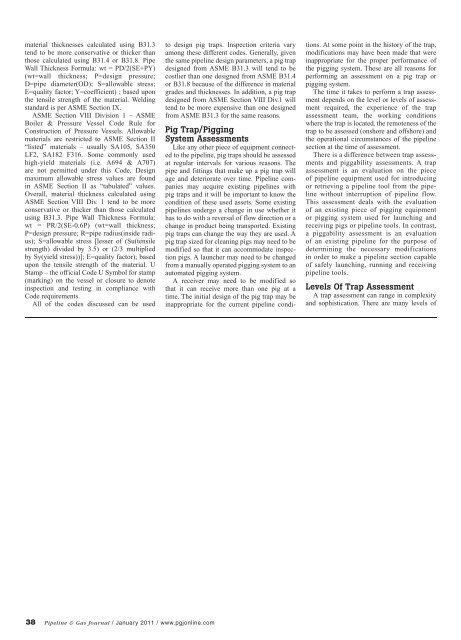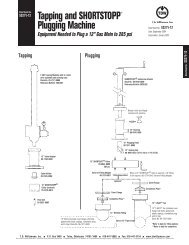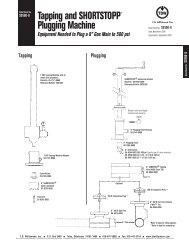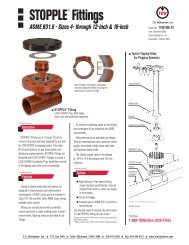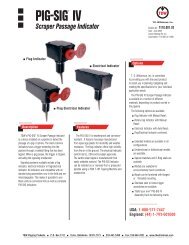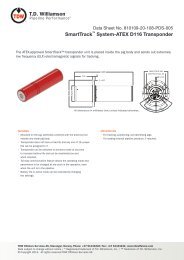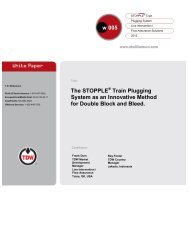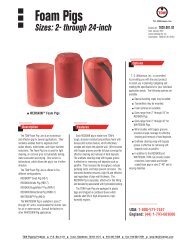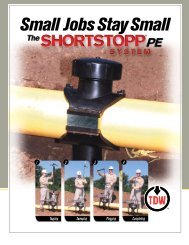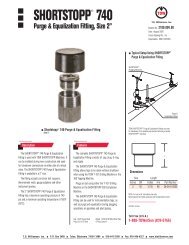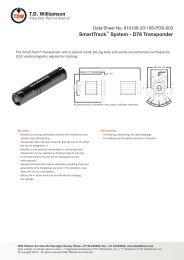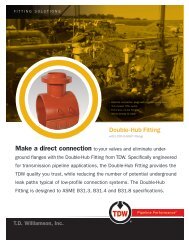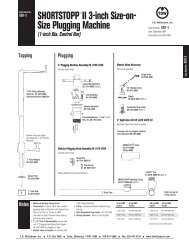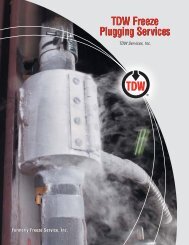Pig Trap Design And Assessment Considerations - T.D. Williamson ...
Pig Trap Design And Assessment Considerations - T.D. Williamson ...
Pig Trap Design And Assessment Considerations - T.D. Williamson ...
Create successful ePaper yourself
Turn your PDF publications into a flip-book with our unique Google optimized e-Paper software.
material thicknesses calculated using B31.3tend to be more conservative or thicker thanthose calculated using B31.4 or B31.8. PipeWall Thickness Formula: wt = PD/2(SE+PY)(wt=wall thickness; P=design pressure;D=pipe diameter(OD); S=allowable stress;E=quality factor; Y=coefficient) ; based uponthe tensile strength of the material. Weldingstandard is per ASME Section IX.ASME Section VIII Division 1 – ASMEBoiler & Pressure Vessel Code Rule forConstruction of Pressure Vessels. Allowablematerials are restricted to ASME Section II“listed” materials – usually SA105, SA350LF2, SA182 F316. Some commonly usedhigh-yield materials (i.e. A694 & A707)are not permitted under this Code. <strong>Design</strong>maximum allowable stress values are foundin ASME Section II as “tabulated” values.Overall, material thickness calculated usingASME Section VIII Div. 1 tend to be moreconservative or thicker than those calculatedusing B31.3. Pipe Wall Thickness Formula:wt = PR/2(SE-0.6P) (wt=wall thickness;P=design pressure; R=pipe radius(inside radius);S=allowable stress [lesser of (Su(tensilestrength) divided by 3.5) or (2/3 multipliedby Sy(yield stress))]; E=quality factor); basedupon the tensile strength of the material. UStamp – the official Code U Symbol for stamp(marking) on the vessel or closure to denoteinspection and testing in compliance withCode requirements.All of the codes discussed can be usedto design pig traps. Inspection criteria varyamong these different codes. Generally, giventhe same pipeline design parameters, a pig trapdesigned from ASME B31.3 will tend to becostlier than one designed from ASME B31.4or B31.8 because of the difference in materialgrades and thicknesses. In addition, a pig trapdesigned from ASME Section VIII Div.1 willtend to be more expensive than one designedfrom ASME B31.3 for the same reasons.<strong>Pig</strong> <strong>Trap</strong>/<strong>Pig</strong>gingSystem <strong>Assessment</strong>sLike any other piece of equipment connectedto the pipeline, pig traps should be assessedat regular intervals for various reasons. Thepipe and fittings that make up a pig trap willage and deteriorate over time. Pipeline companiesmay acquire existing pipelines withpig traps and it will be important to know thecondition of these used assets. Some existingpipelines undergo a change in use whether ithas to do with a reversal of flow direction or achange in product being transported. Existingpig traps can change the way they are used. Apig trap sized for cleaning pigs may need to bemodified so that it can accommodate inspectionpigs. A launcher may need to be changedfrom a manually operated pigging system to anautomated pigging system.A receiver may need to be modified sothat it can receive more than one pig at atime. The initial design of the pig trap may beinappropriate for the current pipeline conditions.At some point in the history of the trap,modifications may have been made that wereinappropriate for the proper performance ofthe pigging system. These are all reasons forperforming an assessment on a pig trap orpigging system.The time it takes to perform a trap assessmentdepends on the level or levels of assessmentrequired, the experience of the trapassessment team, the working conditionswhere the trap is located, the remoteness of thetrap to be assessed (onshore and offshore) andthe operational circumstances of the pipelinesection at the time of assessment.There is a difference between trap assessmentsand piggability assessments. A trapassessment is an evaluation on the pieceof pipeline equipment used for introducingor retrieving a pipeline tool from the pipelinewithout interruption of pipeline flow.This assessment deals with the evaluationof an existing piece of pigging equipmentor pigging system used for launching andreceiving pigs or pipeline tools. In contrast,a piggability assessment is an evaluationof an existing pipeline for the purpose ofdetermining the necessary modificationsin order to make a pipeline section capableof safely launching, running and receivingpipeline tools.Levels Of <strong>Trap</strong> <strong>Assessment</strong>A trap assessment can range in complexityand sophistication. There are many levels of38 Pipeline & Gas Journal / January 2011 / www.pgjonline.com


